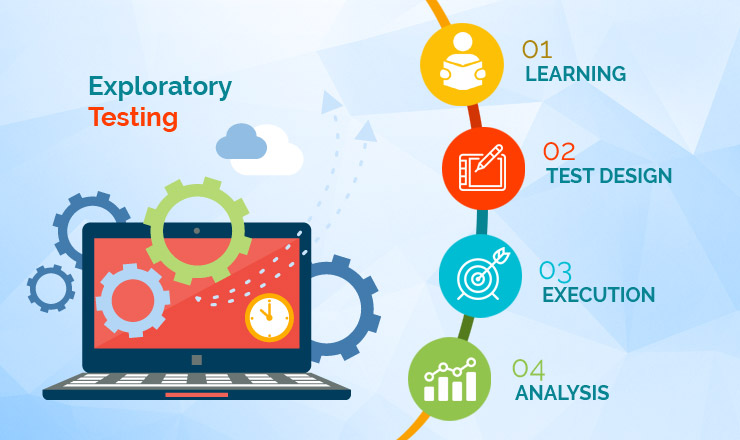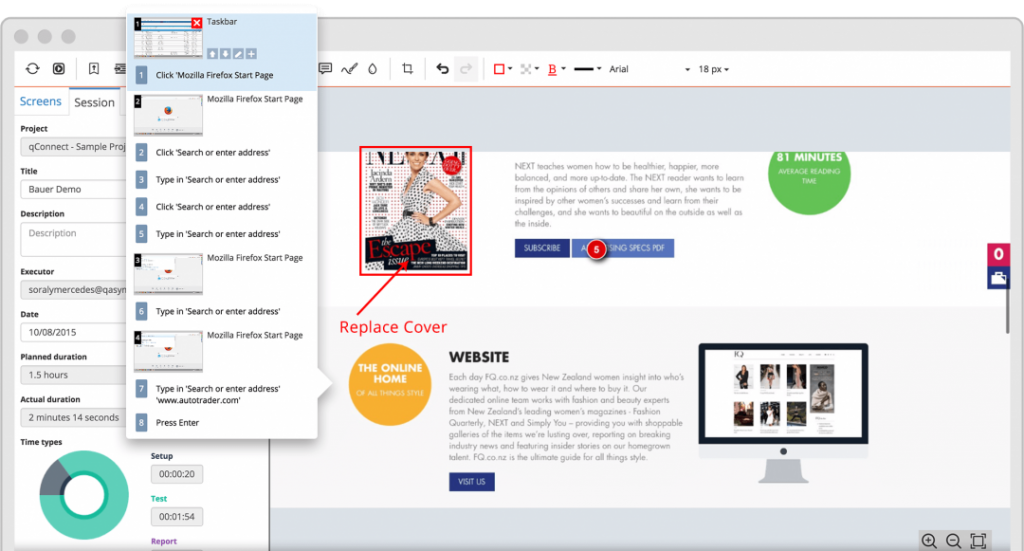
What is Exploratory Testing?
Exploratory testing is a vital aspect of the software quality assurance process. Unlike scripted testing, it focuses on spontaneity, intuition, and domain knowledge. Testers create and execute test cases simultaneously, exploring the application’s functionalities, identifying issues, and making quick decisions on the fly.
When Should You Use Exploratory Testing?
Exploratory testing is typically employed during the following scenarios:
- Early Stages of Development: At the beginning of a project when scripted test cases may not be readily available.
- Complex Systems: For intricate applications where writing exhaustive test cases is impractical.
- Regression Testing: To validate that recent changes haven’t adversely affected existing functionalities.
- Usability Testing: To ensure the user interface is intuitive and user-friendly.
- Ad Hoc Testing: When addressing unpredicted scenarios or unexpected issues.
Where is Exploratory Testing Applied?
Exploratory testing can be applied to various testing levels:
- Functional Testing: To evaluate if the software performs its functions correctly.
- User Interface Testing: Focusing on the visual aspect of the software.
- Integration Testing: To ensure different components work cohesively.
- System Testing: Evaluating the complete software system.
Who Performs Exploratory Testing?
Exploratory testing is best suited for skilled and experienced testers who possess a deep understanding of the domain and can think on their feet. It requires testers to rely on their intuition and knowledge to discover issues quickly.
Why is Exploratory Testing Important?
Exploratory testing offers several advantages, such as:
- Realistic Testing: Testers can simulate real-world scenarios, mimicking user behavior to discover issues often missed in scripted testing.
- Early Issue Detection: It can uncover problems in the early stages of development when they are more cost-effective to fix.
- Enhanced Test Coverage: This method ensures broader test coverage, as it isn’t limited to predefined test cases.
- Usability Assessment: Exploratory testing allows for assessing the software’s user-friendliness, uncovering design and usability issues.
Which Tools Facilitate Exploratory Testing?
Various tools and software can aid in the exploratory testing process:
- Session-Based Testing Management: Tools like “Rainforest” and “Testpad” help manage exploratory testing sessions.
- Test Management Tools: Platforms like “TestRail” allow you to record and track exploratory test cases.
- Screen Recording Tools: Software like “Camtasia” or “OBS Studio” can be used to capture the testing process for documentation.
- Collaboration Tools: Platforms like “Slack” and “Microsoft Teams” facilitate communication among testers during exploratory testing.
- Defect Tracking Tools: Systems like “Jira” help manage issues found during exploratory testing.
Whose Responsibility is Exploratory Testing?
Exploratory testing is a collaborative effort. Testers, developers, and other stakeholders should actively engage in this process. The testers are responsible for conducting the tests, while developers should be ready to address the identified issues promptly.
In a broader sense, the responsibility for exploratory testing falls on the entire project team. It’s not limited to the testing phase; it extends to the development process, design, and user experience stages. This approach ensures that software quality is maintained throughout the project lifecycle.
Exploratory testing definition: Exploratory testing is the approach, to an application’s evaluation, which integrates three things – exploration of the application with design of test scenarios and beginning of the actual testing process. Unlike pre-scripted instructions, exploratory testing needs a tester to listen, read, think and report, effectively and rigorously, thus making this approach as productive (in terms of revealing critical information) as its scripted counterpart.
Download Whitepaper: Use of multiple Test Approaches in DevOps
Here are some major reasons why exploratory testing should be incorporated in the process:
- It helps the tester quickly identify major discrepancies, thus helping to develop the application to meet actual-world requirements of end users.
- It’s cognitively structured compared to the procedural framework of scripted testing.
- It’s an approach and not a technique. The next course of actions is governed by the current course of actions.
- It’s significantly teachable and manageable.
- Exploratory testing itself is highly useful but when dovetailed with other testing processes, it becomes a powerful way to understand the application in a better manner, build better functional tests and finally enhance the quality of the application.
When do we require exploratory testing?
It’s required in the scenarios given below:
- To understand how the application works, what functionality it executes and how its interface looks like.
- To identify historically and untested buggy functionality of the application.
- To compel the application to provide evidence of its capabilities in terms of functionality for which it was developed.
- To minimize test script writing.
- To find new questions and new information.
- When advance iteration is required.
- When new testers enter the project.
- The testing team consists of adept testers.
- The application is critical enough.
Managing exploratory testing
Exploratory test management goes through the following 5 stages:
- 1. Creation of Bug Taxonomy (classification):
- Categorize prevalent types of faults detected in earlier projects.
- Scrutinize the main cause/analysis of the faults or problems.
- Detect the risks and create ideas to evaluate the application.
- 2. Test Charter:
- Test charter should propose What to test, The process of testing, Areas that need to be looked upon
- Test ideas are the initiating points of exploration testing.
- Test charter aids how an end user could utilize the application.
- 3. Time Box:
- It includes two testers working together up to a minimum time frame of 90 minutes.
- Any interrupted time shouldn’t be there in that 90 minutes’ session.
- Time box can have extension or reduction of 45 minutes.
- This session motivates testers to react to the response of the application and to prepare for the accurate outcome.
- 4. Results Reviewing:
- Assessment of the faults
- Getting educated from testing
- Study of coverage areas
- 5. Debriefing:
- Compilation of output results
- Comparison between the results and the charter
- Check for need of any additional testing
During an exploratory test, following points need to be covered:
- Mission of the testing should be absolutely clear
- Keeping notes on what requires to be tested, requirement of the testing and the evaluation of the application quality
- Tracking of issues and questions raised during the testing
- Pairing of the testers for successful testing
What to leverage from exploratory testing?
Exploratory testing is a part of Agile testing continuum that ranges from casual exploratory testing to proper testing scripts. Most testing engagements require a merger of various testing approaches, making the most out of each to harvest optimum value from testing efforts.
During the casual exploratory testing, the application’s basic functionality is captured, by formulating a practical decomposition of application space, within a spreadsheet or test management tool. Then this practical decomposition is verified with development, production and business support teams, and proper adjustments are made.
Now skilled testers are assigned against certain application areas while the practical decomposition acts like a check-list. At the beginning, focus of the testers should stay on four prime goals: learning about application space, finding and publishing defects, capturing test case names and confirming the practical decomposition.
Based on the information gained, the requirement of additional testing process is decided to meet software quality goals and testing velocity. Leverage the information obtained from continuing formal exploratory testing can help develop an itemized inventory of test cases. This inventory should be formally scripted and automated using automation techniques and keyword-based test case design.
Here, the key lies in the perfect blend of techniques, tools and skills that pave way for the highest possible opportunity to lower production issues and enhance product quality.
Our Partner QASymphony Testing Platform: qTest eXplorer Exploratory testing tool
qTest eXplorer is an innovative exploratory testing tool that produces detailed step-by-step and multi-screen capture documentation. Click here
Download Whitepaper: Role of QA in Digital Transformation
Final words
When you are solving puzzles, perhaps you have noted how the puzzle changes the puzzling. As you dive into the process of solving a puzzle, its particulars emerge, which often influences your tactics for solving it. This is the truth that lies at the heart of exploratory testing.
Though testing is, in itself, quite complicated, effective and strategic use of exploratory testing can tame that complexity to a significant extent and help in the development of high-quality applications at a rapid pace.
In conclusion, exploratory testing is a crucial aspect of software quality assurance. Its flexibility and focus on real-world scenarios make it indispensable in ensuring software reliability. By engaging experienced testers, leveraging the right tools, and fostering collaboration, your project can benefit significantly from exploratory testing, uncovering hidden issues and delivering a more robust software product.
More Related Blog

Key challenges in Test Environment Management (Updated JAN 2024)
Test Environment Management (TEM) refers to directing, controlling and managing the enterprise level test environments. It consists of using procedures, tools and resources to manage multiple components like software,hardware, databases, test data and applications......
Read More
Software Testing Lessons You Can Take From Pokemon Go
Unless you’ve been living under the rock, you know Pokemon Go pretty well. This location-based, augmented reality game has created a rage in the gaming industry. Within a few weeks of its launch, the game’s daily active users are neck … Continue reading "Software Testing Lessons You Can Take From Pokemon Go"...
Read More
